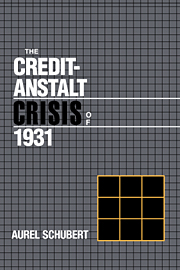Book contents
- Frontmatter
- Contents
- Tables
- Preface
- The Credit-Anstalt Crisis of 1931
- 1 Introduction
- 2 Diary of the crisis
- 3 Financial crisis theories and the Austrian experience of 1931
- 4 The causes of the financial crisis
- 5 The financial crisis and market efficiency
- 6 The financial crisis and economic activity
- 7 The financial crisis and the lender of last resort
- 8 Alternative policies and policy implications
- 9 Conclusions
- Bibliography
- Index
3 - Financial crisis theories and the Austrian experience of 1931
Published online by Cambridge University Press: 20 March 2010
- Frontmatter
- Contents
- Tables
- Preface
- The Credit-Anstalt Crisis of 1931
- 1 Introduction
- 2 Diary of the crisis
- 3 Financial crisis theories and the Austrian experience of 1931
- 4 The causes of the financial crisis
- 5 The financial crisis and market efficiency
- 6 The financial crisis and economic activity
- 7 The financial crisis and the lender of last resort
- 8 Alternative policies and policy implications
- 9 Conclusions
- Bibliography
- Index
Summary
Historic associations, by themselves, never teach lessons. Lessons derive from history interpreted in the light of theories.
–L. B. Yeager, 1976Definitional problems
Recently, due to the fear of large-scale insolvencies in the international banking sector, considerable attention has been given to financial crises as causes of economic fluctuations, and a respectable volume of literature reflects this renewed interest.
Although their common themes are financial crises, it soon became obvious that this term is used to characterize very diverse facts, and the reader cannot help becoming somewhat confused about the question of what really constitutes a financial crisis. How widespread this confusion is, even within the economic profession itself, is reflected in Schwartz's (1986) study entitled “Real and Pseudo-Financial Crises,” where she restates and extends Goldsmith's (1982, 42) view that many of the crises identified in the literature, by Minsky (1982), Kindleberger (1978), and others, were only “at most potential or near crises.” The proposition that a financial crisis is like a pretty girl – difficult to define but recognizable when seen (Kindleberger and Laffargue, 1982, 2) – seems to lead to ambiguous results, as some economists see “pretty girls” where others only recognize “pseudo-pretty girls.”
The underlying problem is the fact that no clear definition of a financial crisis exists – that is, there is no objective and accepted yardstick by which an economic event can be measured for its qualifications as a financial crisis.
- Type
- Chapter
- Information
- The Credit-Anstalt Crisis of 1931 , pp. 19 - 30Publisher: Cambridge University PressPrint publication year: 1992



